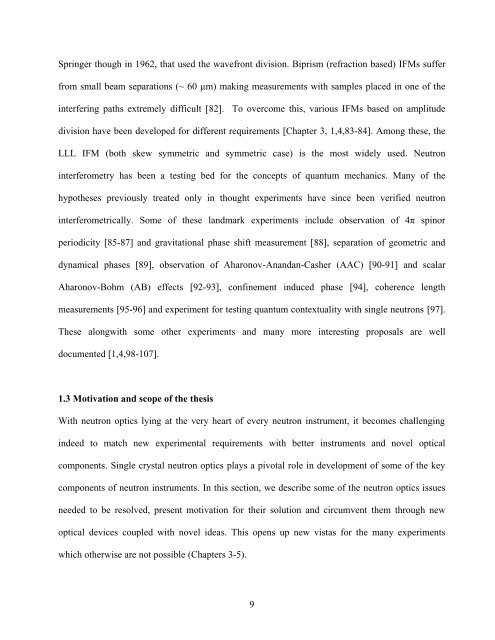PHYS01200804001 Sohrab Abbas - Homi Bhabha National Institute
PHYS01200804001 Sohrab Abbas - Homi Bhabha National Institute
PHYS01200804001 Sohrab Abbas - Homi Bhabha National Institute
Create successful ePaper yourself
Turn your PDF publications into a flip-book with our unique Google optimized e-Paper software.
Springer though in 1962, that used the wavefront division. Biprism (refraction based) IFMs suffer<br />
from small beam separations (~ 60 μm) making measurements with samples placed in one of the<br />
interfering paths extremely difficult [82]. To overcome this, various IFMs based on amplitude<br />
division have been developed for different requirements [Chapter 3, 1,4,83-84]. Among these, the<br />
LLL IFM (both skew symmetric and symmetric case) is the most widely used. Neutron<br />
interferometry has been a testing bed for the concepts of quantum mechanics. Many of the<br />
hypotheses previously treated only in thought experiments have since been verified neutron<br />
interferometrically. Some of these landmark experiments include observation of 4π spinor<br />
periodicity [85-87] and gravitational phase shift measurement [88], separation of geometric and<br />
dynamical phases [89], observation of Aharonov-Anandan-Casher (AAC) [90-91] and scalar<br />
Aharonov-Bohm (AB) effects [92-93], confinement induced phase [94], coherence length<br />
measurements [95-96] and experiment for testing quantum contextuality with single neutrons [97].<br />
These alongwith some other experiments and many more interesting proposals are well<br />
documented [1,4,98-107].<br />
1.3 Motivation and scope of the thesis<br />
With neutron optics lying at the very heart of every neutron instrument, it becomes challenging<br />
indeed to match new experimental requirements with better instruments and novel optical<br />
components. Single crystal neutron optics plays a pivotal role in development of some of the key<br />
components of neutron instruments. In this section, we describe some of the neutron optics issues<br />
needed to be resolved, present motivation for their solution and circumvent them through new<br />
optical devices coupled with novel ideas. This opens up new vistas for the many experiments<br />
which otherwise are not possible (Chapters 3-5).<br />
9
















